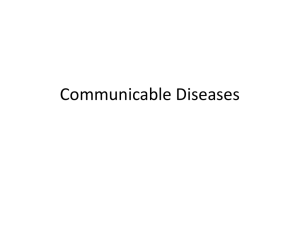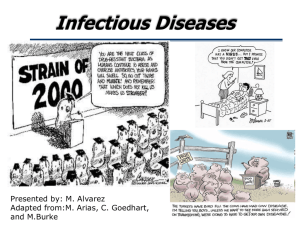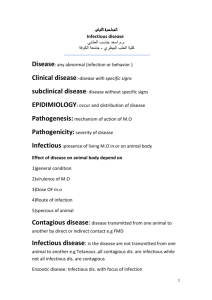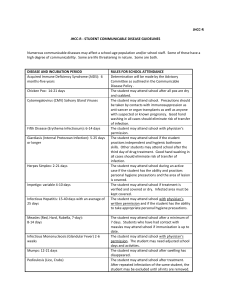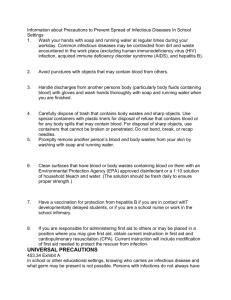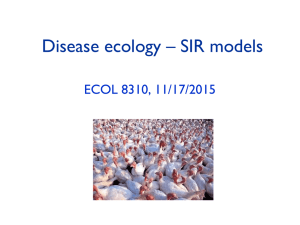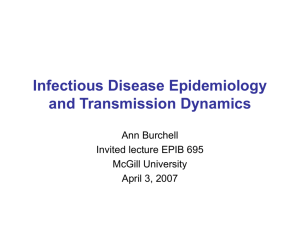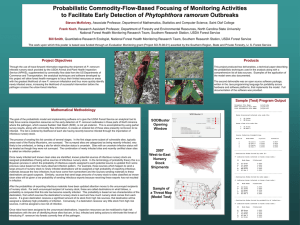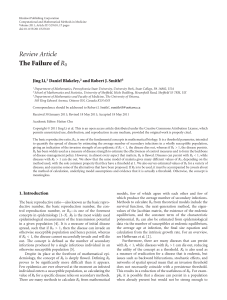Communicable Diseases
advertisement
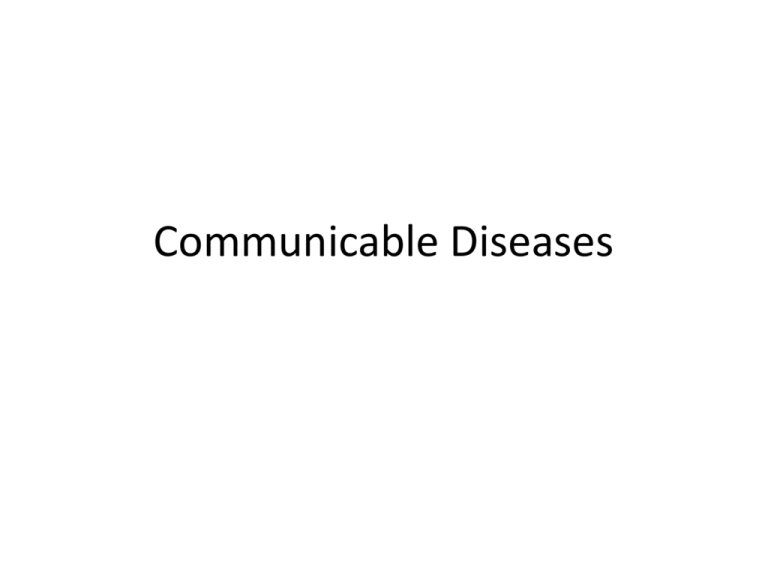
Communicable Diseases Figure 2.10: The Burden of Disease by Group of Cause, Percent of Deaths, 2001 Data from Lopez AD, et al Global Burden of Disease and Risk Factors. Washington, DC and New York: The World Bank and Oxford University Press; 2006:8. Table 2.5: The Ten Leading Causes of Death in Children Ages 0-14, by Broad Income Group, 2001 Adapted with permission from: Lopez A, Begg S, Bos E. Demographic and Epidemiological Characteristics of Major Regions, 1990-2001. In: Lopez A, Mathers C, Ezzati M, Jamison D, Murray C, eds. Global Burden of Disease and Risk Factors. Washington, DC and New York: The World Bank and Oxford University Press; 2006:70. Key Terms • Communicable diseases includes: – Those caused by infectious agents, such as: • • • • Malaria HIV/AIDS TB Cholera – Those caused by parasites, such as: • Hookworm • Filariasis Studying Communicable Diseases • Many aspects to the study of communicable diseases – Infectious organism and its transmission vector • Life cycle and reservoir (where it lives) of the infectious organism/parasite and/or transmission vector • Cycle of infection – Human to human; host to insect to human… – – – – Pathology of the organism in the body Diagnosis Treatment Prevention Modes of Transmission • Direct contact - person to person – Contact with an infected skin lesion – Contact with blood or other body fluids • Contact with fecal material of a sick person and then touch your eyes, nose…. – Breathe in droplets expelled by coughing/sneezing sick person (some consider this airborne) – Sexual contact – Needle sharing Modes of Transmission • Airborne – Pathogen is aerosolized, attached to dust…in the air – Become infected by breathing in the infected air – Isolation of the infected individual is recommended to prevent transmission – Examples: SARS (TB , influenza) Modes of Transmission • Vector-borne – Spread by an animal - often by the bite of an infected insect • • • • Rabies – animal bite Malaria – mosquito Lyme disease - ticks Dengue fever – mosquito – Insect itself is often infected by biting an infected carrier • Rodent with plague tick human • Livestock with African sleeping sickness tsetse fly human Modes of Transmission • Food and water borne – Infection occurs with ingestion of contaminated food or water • Water borne: – Cholera – Hepatitis A • Food borne – often fecally contaminated or contaminated water used to cook foods – Salmonella – E. coli Modes of Transmission • Mother-to-child (MTC) – Referred to as vertical transmission – Infection is passed from mother to fetus during pregnancy or mother to infant through breast milk More Key Terms • Infection – occurs when the infectious agent begins to reproduce in the body – may result in a “case” – person with disease (symptoms) – Can be infected without disease! • Typhoid Mary • Pathogenicity – # with disease (symptoms) per # infected • Virulence - # with severe illness or death per # with disease – Aka case fatality rate More Key Terms • Infectivity – capacity of the organism to cause infection in a susceptible individual • Measure infectivity by: – Secondary attack rate – average number of other people one sick person infects • # infected/# susceptible people exposed • Prions Infectious Agents – Protein based infectious particles • Viruses – Genetic material (DNA, ssDNA, RNA…) inside a protein capsid – Many are vaccine preventable • Bacteria – Prokaryotes – Some vaccine preventable • Protozoa – Eukaryotes • Fungus – Eukaryotes (molds and yeast) • Worms – Parasitic multi-celled eukaryotes Timeline of Infection Pre-Clinical Phase • Infection occurs • Disease can be detected through lab work Contagious • Infected person may become contagious before or after symptoms begin Clinical Phase • Symptoms develop • Person recovers with or without immunity or dies Major Infectious Diseases Worldwide • HIV/AIDS – Virus • Malaria – protozoa • Tuberculosis (TB) – bacteria • Measles – virus Neglected Tropical Diseases (NTD) • Diseases that have a significant impact on health and quality of life, but are generally not deadly • http://www.who.int/neglected_diseases/en/ – ~23 minute video on the forgotten diseases • http://whqlibdoc.who.int/publications/2010/9 789241564090_eng.pdf


